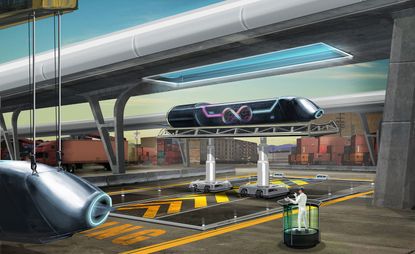Hyperloop wants to connect major European cities with high-speed trains
Traveling from Vienna to Budapest might get a whole lot faster

Vienna to Bratislava in eight minutes flat: that’s exactly what Hyperloop Transportation Technologies (HTT) is hoping to do with their new proposed high-speed train. The company recently signed a deal with the government of Slovakia to investigate the possibility of building a Hyperloop that would link three European capitals.
The route would include Vienna, Austria to Bratislava, Slovakia, and from Bratislava to Budapest, Hungary. Though a sub 10-minute ride might seem impossible, the distances between the cities are not that far. Vienna to Bratislava is 35-miles straight and Bratislava to Budapest is a 100 miles, making it take just two minutes longer than the Vienna route. HTT also believes it’s possible they could link Slovakia's second-largest city, Košice, which is 248 miles away.
While these plans are just in the research phase, there certainly seems to be a lot of interest in the project. Tesla and PayPal founder, Elon Musk, initially came up with the transportation concept and now two companies are working to make Hyperloop a reality. Along with HTT, Hyperloop Technologies (similar name, different company) has started it’s own testing in North Las Vegas and already has backing from venture capitalists.
The project was also a hot topic at SXSW in Austin, Texas. Hyperloop Transportation Technologies CEO Dirk Alhborn showed off his idea for 'Augmented Windows' during the annual festival, which would allow passengers to comfortably look out the window of the train while traveling at the speed of sound.
More than just a window with a video screen, Alhborn said this technology would allow passengers to see an outside landscape, advertisements, and information. 'These screens use head tracking to see where you're looking and, based on your position, we are actually manipulating the image so that you have the same feeling as looking out the window,' Ahlborn said on March 13. 'And we are working on ways that multiple people can be looking out the same window.'
He added, 'Psychologically, it's really important to have the possibility to look out of the window, but also it's an experience. Imagine, you can be in a virtual world and travel through Jurassic World, Terminator-land and maybe your trip is sponsored by those companies through the advertising.'
This article originally appeared on Travel + Leisure
Wallpaper* Newsletter
Receive our daily digest of inspiration, escapism and design stories from around the world direct to your inbox
-
 The Brazilian Forest House injects art into a modernist-inspired, contemporary design
The Brazilian Forest House injects art into a modernist-inspired, contemporary designThe Brazilian Forest House, designed in upstate São Paulo by FGMF, brings together nature and art
By Ellie Stathaki Published
-
 Waiting room inspo: Inside Studioutte’s cinematic Sala D’Attesa at Milan Design Week
Waiting room inspo: Inside Studioutte’s cinematic Sala D’Attesa at Milan Design WeekStudioutte’s Sala D’Attesa, staged in Nolo during Milan Design Week 2024, was a scenographic interior merging different design sensibilities
By Laura May Todd Published
-
 Bang & Olufsen’s Recreated Classics series continues with a CD player revival
Bang & Olufsen’s Recreated Classics series continues with a CD player revivalBang & Olufsen’s Beosystem 9000c music system brings the original digital compact disc format back to life and pairs it with the latest in speaker design
By Jonathan Bell Published